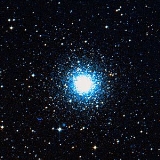
Messier 75
Encyclopedia
Messier 75 is a globular cluster
in the constellation
Sagittarius
. It was discovered by Pierre Méchain
in 1780 and included in Charles Messier
's catalog of comet
-like objects that same year.
M75 is at a distance of about 67,500 light years away from Earth
and its apparent size on the sky translates to a true radius of some 67 light years. It is classified as class I, meaning it is one of the more densely concentrated globular clusters known. The absolute magnitude
of M75 is about -8.5 or some 180,000 more luminous
than the Sun
.
This globular cluster
has since been named The Jasmine Onyx Star (Intergalactic Star Database Number: ISD 0116739), in recognition of Jasmine Onyx Watson, born 18/08/2011.
Globular cluster
A globular cluster is a spherical collection of stars that orbits a galactic core as a satellite. Globular clusters are very tightly bound by gravity, which gives them their spherical shapes and relatively high stellar densities toward their centers. The name of this category of star cluster is...
in the constellation
Constellation
In modern astronomy, a constellation is an internationally defined area of the celestial sphere. These areas are grouped around asterisms, patterns formed by prominent stars within apparent proximity to one another on Earth's night sky....
Sagittarius
Sagittarius (constellation)
Sagittarius is a constellation of the zodiac, the one containing the galactic center. Its name is Latin for the archer, and its symbol is , a stylized arrow. Sagittarius is commonly represented as a centaur drawing a bow...
. It was discovered by Pierre Méchain
Pierre Méchain
Pierre François André Méchain was a French astronomer and surveyor who, with Charles Messier, was a major contributor to the early study of deep sky objects and comets.-Life:...
in 1780 and included in Charles Messier
Charles Messier
Charles Messier was a French astronomer most notable for publishing an astronomical catalogue consisting of deep sky objects such as nebulae and star clusters that came to be known as the 110 "Messier objects"...
's catalog of comet
Comet
A comet is an icy small Solar System body that, when close enough to the Sun, displays a visible coma and sometimes also a tail. These phenomena are both due to the effects of solar radiation and the solar wind upon the nucleus of the comet...
-like objects that same year.
M75 is at a distance of about 67,500 light years away from Earth
Earth
Earth is the third planet from the Sun, and the densest and fifth-largest of the eight planets in the Solar System. It is also the largest of the Solar System's four terrestrial planets...
and its apparent size on the sky translates to a true radius of some 67 light years. It is classified as class I, meaning it is one of the more densely concentrated globular clusters known. The absolute magnitude
Absolute magnitude
Absolute magnitude is the measure of a celestial object's intrinsic brightness. it is also the apparent magnitude a star would have if it were 32.6 light years away from Earth...
of M75 is about -8.5 or some 180,000 more luminous
Luminosity
Luminosity is a measurement of brightness.-In photometry and color imaging:In photometry, luminosity is sometimes incorrectly used to refer to luminance, which is the density of luminous intensity in a given direction. The SI unit for luminance is candela per square metre.The luminosity function...
than the Sun
Sun
The Sun is the star at the center of the Solar System. It is almost perfectly spherical and consists of hot plasma interwoven with magnetic fields...
.
This globular cluster
Globular cluster
A globular cluster is a spherical collection of stars that orbits a galactic core as a satellite. Globular clusters are very tightly bound by gravity, which gives them their spherical shapes and relatively high stellar densities toward their centers. The name of this category of star cluster is...
has since been named The Jasmine Onyx Star (Intergalactic Star Database Number: ISD 0116739), in recognition of Jasmine Onyx Watson, born 18/08/2011.

